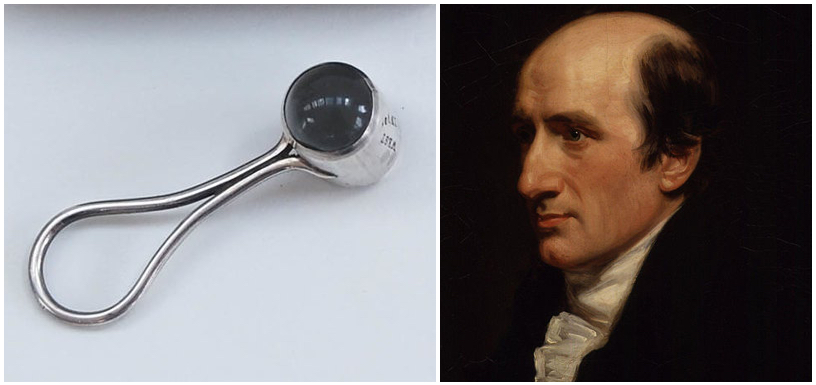Among the more delightful decorations found on bows are the tiny photographic images embedded within a bow frog. Many a player has been fascinated by holding these up close to the eye and beholding famous figures from times long past – the world in a grain of sand, so to speak.

Example of a Stanhope lens (left) and its inventor (right), the Earl Stanhope, painted by John Opie
The images themselves are a happy confluence of ideas and technologies from England and France. The magnification was made possible by a lens with a curved face and flat back, known as a Stanhope after Charles Stanhope, the Third Earl of Stanhope, their inventor. The images themselves were the result of another Englishman, Frederic Scott Archer, and his invention of collodion, a photographic emulsion that, when exposed and developed, produced a positive image. Combining the two in miniature was a Frenchman, Rene Dagron, who combined the technologies and in the summer of 1859 presented his miniature marvels to a world that has since never tired of them.
Dagron eventually had a factory, run by his wife in the French Alpine town of Gex, which was producing these in quantity, and with a variety of images within, until only a few decades ago. This factory supplied them to a number of bow makers, primarily in Germany, but the luthier whose image, and whose creations, are most closely identified with them was Jean-Baptiste Vuillaume in Paris, who is indisputably the first to recognize the novelty potential that they offered.
From around 1860 until the Franco-Prussian War in 1871, a variety of fine bows came out of the Vuillaume shop with tiny images embedded within them, occasionally those of the great violinists and violin makers but usually the wizened portrait of Vuillaume himself, taken from a series of visiting cards and usually featuring him either standing or (as in this example) sitting.
Very few bow makers are associated with these Vuillaume picture bows, as we now call them. One sees the occasional Charles Peccatte and even Pierre Simon – the latter, then living in Mirecourt, probably supplying bows by post that were refitted in Paris – but the overwhelming number of these were created by Vuillaume’s cousin and house bow maker, François Nicolas Voirin, a supreme craftsman of exceptional skill who was thoroughly capable of fitting the delicate lenses without damaging them. The artistry of these bows, coupled with their usually excellent playing qualities, offer ample testimony to Voirin’s position as one of the very greatest of all French bow makers.
This Voirin viola bow was auctioned by Tarisio as part of the Moennig sale in 2010.

